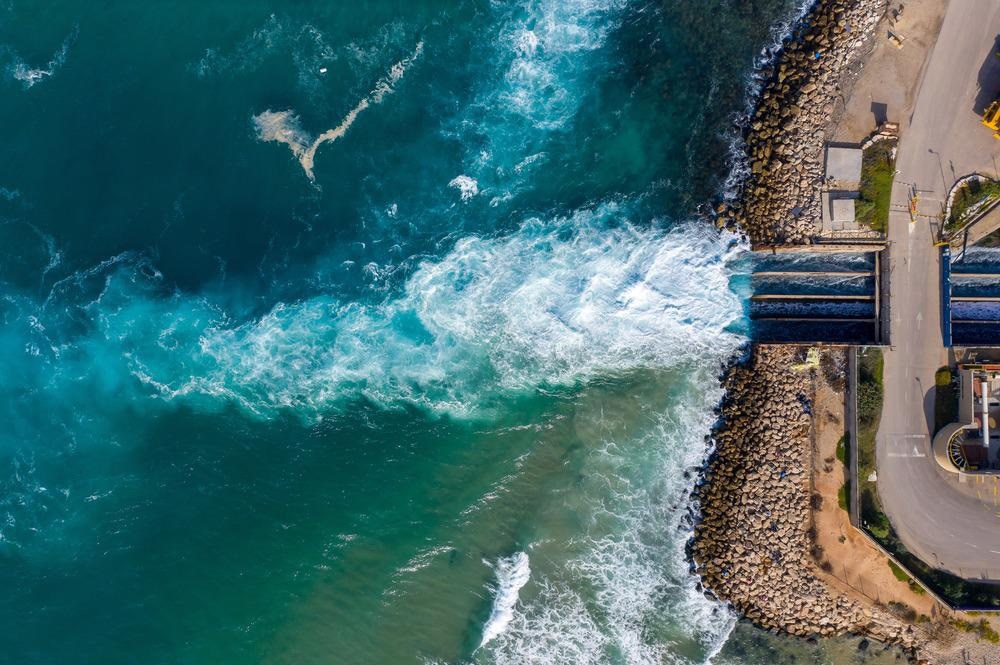The latest research in the journal ACS Applied Sciences deals with the synthesis of hierarchical MnO2 nanosheets on cotton fabric (Mn-CF) for solar-driven water evaporation.

The largest water desalination facility in the world, Hadera Israel. Study: Hierarchical MnO2 Nanosheets Grown on Cotton Fabric as a Flexible and Washable Solar Evaporator for Seawater Desalination. Image Credit: Luciano Santandreu/Shutterstock.com
The study reveals that the lack of availability of freshwater all over the world and the energy crisis are the major problems of the modern digital world. Governments all over the world are focused on ensuring a sustainable and continuous supply of clean water to the people.
Advantages of Desalination of Seawater
Although 98% of the Earth's area is covered with water, it is too salty to be utilized for drinking purposes. The major technique to make seawater drinkable is desalination. Desalination is a procedure that removes minerals from salty water. Desalination, in a broader sense, refers to the elimination of salts and minerals from a target material.
Classic Desalination Techniques
Conventional desalination and purification procedures include thermal distillation treatment and reverse osmosis membrane utilization. Distillation is the process of evaporating and condensing a fluid. The resultant dehydrated product is salt-free. This fundamental idea, which is as natural as rain, is commonly applied to seawater desalination.
The usage of an osmosis membrane is required for reverse osmosis (RO) distillation (i.e., one that allows water to pass through it at much higher rates than dissolved salts). This method is based on the use of a membrane barrier to isolate salt from seawater. Because reverse osmosis requires far less energy to operate than distillation, it is utilized on a wider scale than distillation.
Limitations of Classic Desalination Techniques
Certain limitations exist during the implementation of these techniques. The RO procedure wastes a lot of water, which is the main downside. Between 2 to 20 gallons of water are wasted for every gallon of water produced.
However, both of these processes require a high energy source and also are costly so the financial constraint is another issue. Many chemicals, including chlorine, CO2, and hydrochloric acid are used or produced during the desalination process and can be toxic in high amounts.
Hence an alternative process was needed to overcome these problems.
Importance of Cotton Fabrics
Cotton fabrics (CF) are essential items in our regular lifestyle. Industrial CF is white and is woven from fiber bundles with an approximate width of 20 μm. The hydrophobic characteristics of CF, as well as its high porosity, promote water transfer and vapor discharge.
Can Sea Water Desalination Save The World?
Video Credit: CNBC/YouTube.com
Furthermore, cellulose-based CF can be modified with nanoparticles and react with oxidizing agents. The salts produced on photothermal substances during desalination are easily removed from CF-based composites due to their robust and washable properties.
Incorporation of CF in Solar Steam Generators
Researchers have been motivated by CF to use inexpensive, industrial sale, reusable photothermal materials for desalination. In the latest study, an electrodeposition approach for producing progressive MnO2 nanofibers developed on CF as hybrid photothermal materials (Mn-CF) for solar-powered steam generators was established. The CF is prepared by soaking it in a diluted KMnO4 solution.
Research Findings
The latest research shows that the surface of the CF is coated by nanosheets that resemble "lawn". On the "lawn," several nanoflower-like structural particles (1 m in diameter) are haphazardly placed. The spectroscopy indicated that the major elements consisted of manganese, oxygen, and carbon present in concentrations of 7.03, 42.51, and 49.35 by percentage.
The nanosheet lawn and nanoparticle flower structure particles may be useful for absorbing light and increasing the rate of solar steam evaporation.
Water Transportability
Photothermal materials' wettability and water transportability are critical in ISSG devices. A high-speed camera was used to film the absorption rate of a water droplet on the dry CF and Mn-CF surface to explore the water transportability of CF. Mn-CF entirely absorbed a water droplet in 5 s, which was longer than CF (within 2 s).
These findings suggest that both CF and Mn-CF have outstanding hydrophilic and water transport capabilities, which are advantageous for solar vapor production. It was also observed that the photothermal capacity of Mn-CF is stronger than that of CF.
Cost Analysis
Financial aspects are quite essential in the modern world. Depending on the synthesis process and desalination effectiveness, the cost of creating 1 m2 of Mn-CF is around $1.5, which may yield approximately 3.8 kg of desalinated water in the first 3 hours under 1 solar irradiation, meeting an adult's daily water demand.
In short, an inexpensive, durable, and washable photothermal material made of hierarchical MnO2 nanosheets grown on CF was evaluated and shown to be beneficial in the provision of fresh drinkable water.
References
Xiong, J., Zhang, Z., Yi, J., Li, B., Wang, X., Wng, Y., . . . Peng, J. (2021). Hierarchical MnO2 Nanosheets Grown on Cotton Fabric as a Flexible and Washable Solar Evaporator for Seawater Desalination. ACS Applied Nanomaterials. https://pubs.acs.org/doi/abs/10.1021/acsanm.1c03089
Disclaimer: The views expressed here are those of the author expressed in their private capacity and do not necessarily represent the views of AZoM.com Limited T/A AZoNetwork the owner and operator of this website. This disclaimer forms part of the Terms and conditions of use of this website.